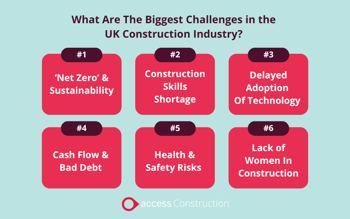What Are The Biggest Challenges In The Construction Industry? – & How To Tackle Them
The construction industry is one of the largest sectors of the UK economy. Now, as the sector navigates rising inflation and crises such as the War in Ukraine, we review the current main challenges in the construction industry and how to mitigate their impact.
What Are The Main Challenges In The Construction Industry In 2024?

1. ‘Net Zero’ & Sustainability Issues
The UK Government's goal of ‘net zero’ by 2050 has made waves in the construction industry.
Construction accounts for around 40% of total UK carbon emissions. The net zero deadline poses a huge challenge, and the construction sector needs to position itself as a big part of the solution. Companies will have to adapt to legislative changes surrounding sustainability, such as whole-life carbon assessments. Contractors will also need to learn new green skills and adopt new technology.
The UK Green Building Council estimates that over the next 30 years 95% of construction emissions will come from existing buildings. This means a push on retrofitting work and a greater need for energy assessors and insulation installers going forward. Modern methods of construction, such as off-site manufacturing and modular construction are likely to become more common.
The demand for more sustainable materials has already seen an increase and this is forecast to continue. However, a push for net zero in the industry is not all bad. Younger generations show a keen interest in sustainability which could help with labour shortages and presents an opportunity to plug the skills shortage gap.
Read our article on carbon-first in construction >

2. The Construction Skills Shortage
Many challenges in construction stem from the labour shortage in construction - labour costs, project delays, supply chain instability - making it arguably the biggest challenge facing construction.
An additional 225,000 workers will be required to meet UK construction demand by 2027. Finding young talent to fill the labour shortage has proven to be a difficult task. In 2018, the Union of Construction, Allied Trades and Technicians reported a 14.6% fall in apprenticeship numbers. There is a glimmer of hope for the industry in 2024, with apprenticeship numbers rising for the first time since 2016, but there is a long way to go to fill the gap.
There is a perceived low image of the industry amongst younger generations which must be tackled. In the Construction 2025 report this was attributed to a lack of diversity, long hours, low pay and little job security. A lack of young people interested in construction work means each experienced worker that retires leaves a significant skill gap. Sixty-one percent of the current construction workforce is set to leave the industry in the next decade. Essential trade skills are lost each time an employee retires, but projects are increasing in complexity and demand. This forces businesses into outsourcing talent, which has a knock-on effect on project budgets.
Steps can be taken to try and mitigate long-term effects. Focusing and investing in skills development for current employees will increase productivity. Stricter onboarding processes improves the capability of a team from the outset. Mentoring students and graduates or offering apprenticeship programs may also encourage younger talent to show interest in your company. Showing progression in the forms of technology adoption, sustainability and diversity will also go a long way in making construction more desirable as an industry in which to build a career.
Learn more about skills shortages in the construction industry >

3. Lack of Joined-Up Thinking
Construction has the most pressure groups, specialist bodies and agencies than any other industry. Each has an influence over standards and methods of working. Regulation changes mid-project can cause delays, cancellations and rework.
Keeping up with the constant changes happening in the sector takes time and resources that smaller businesses often do not have. Rules and regulations can span from worldwide compliance down to local politics and it is easy to miss notifications on the latest changes. This can have a detrimental effect on companies. Having to go back and re-do work to account for recent changes is an expensive task. Dedicating set times to check for any updates each day will help the process become routine. Also, setting up specific inboxes for updates will prevent them getting lost amongst daily work emails.
A lack of joined-up thinking is not solely at macro-level. Communication between teams on a project is a frequent reason for disputes and delays. The flow of information from pre-construction through to completion is often disconnected due to the competitive nature of the industry, leading to inefficiencies across projects. Common issues such as miscommunications or incorrect data can easily be solved by implementing construction software, ensuring a single source of truth.
Learn more about encouraging collaboration in construction projects >
4. Missed Opportunity of Technology Adoption
The construction industry is notoriously hesitant to adopt new methods and technologies. This often comes down to businesses not having the time or budget to teach staff new ways of working.
McKinsey Globe Institute named construction the second least digitised sector in the world. Productivity levels are lower than the UK average, which could be remedied by adopting more efficient digital methods.
One major issue with slow technology adoption is haphazard document management. Tracking and managing the vast number of documents produced through each project is a laborious admin task. Manually managing documentation is slow and leaves room for human error. Moving to a paperless centralised data system standardises data and gives everyone a more accurate view of each project. Efficient digital document management allows for in-depth analysis, improved forecasting and better margins.
Find out more about our construction software solutions >
5. Cash Flow & Bad Debt
Bad debt in the construction industry is still a prevalent issue. There is £300 million in bad debt in the UK construction industry entering 2023, which could rise to £1 billion by 2024.
Research predicts more than 100 firms in the construction sector could collapse each week in 2024, exacerbating supply chain issues. A steady cash flow is crucial for construction. Your suppliers want to be paid after they have completed their work and do not care if your client has not paid. Having free cash to be able to pay subcontractors and suppliers before the project completion is necessary to avoid disputes, delays and damage to your reputation.
Company owners are often not trained in managing finances and do not have a background in accounting. Financial skills are learnt on the job, and so fund management is a common issue amongst construction firms. Combined with forgetful clients or unreliable subcontractors, a steady cash flow becomes an arduous task.
A solution to the cash flow problem, to prepare for worst case scenarios, starts by building a strong business credit profile. There are practical steps to achieve this:
- Set up project bank accounts where money is held in escrow.
- Make sure paperwork and contracts are all in order with necessary signatures.
- If a client requests a change mid-project, make sure you have written signed agreements that can be referred to.
- Choose reliable subcontractors by asking suppliers or subcontractors you regularly work with to give recommendations.
- Check licenses and insurance before finalising a hire.
- Take every opportunity to build networks and upskill employees.
Overall, a healthy cash flow comes down to doing your research and surrounding the business with people you trust.
Future-Proof your Construction Business with Access Construction Software
Access Construction provides industry-leading construction software to over 1,000 contractors in the UK and Ireland. Our products include the leading construction ERP, Access Coins, and our construction estimating software, Access ConQuest.
6. Health & Safety Risks
In 2021, construction was ranked as the most dangerous industry to work in. Despite health and safety initiatives, working with heavy machinery or heights means injuries are more likely to happen.
Accidents cause lawsuits and higher insurance premiums, which have a negative impact on a brand reputation and cash flow. Injuries also mean that you will have less available employees, which can be detrimental given the current skills shortage. Failing to keep on top of health and safety compliance - such as onsite training, equipment compliance and accreditations - can result in fines as well as putting employees at higher risk. One of the main reasons for injuries is poor health and safety training. Setting up digital processes with alerts for regular training and maintenance checks will help keep you compliant. Ensuring all employees are properly onboarded and regularly trained will also go a long way in mitigating the risk of injury.

7. The Need For More Women In Construction
A lack of women in construction is a pervasive issue. Despite career opportunities in the industry, many women are put off by its 'macho' stereotype of physical and messy work.
The percentage of women in the construction workforce has risen to 15% over many years but the percentage within trades remains poor. To fill the labour shortage, a bigger interest in trade work is needed.
One way of breaking the stigma that 'construction is a man’s job' is through the tone of voice, language and imagery used in recruitment processes. Finding recruitment agencies that can offer advice on diversifying role descriptions in job adverts will help attract a wider pool of talent. However, retaining employees is equally important. There needs to be a focus on building an environment that women feel comfortable in, whether that is reviewing current company policies or even offering current employees diversity training.
Learn more about why there is a lack of women in construction >
More construction software information, guidance and advice

What Is Cost Value Reconciliation (CVR) In Construction?
Go to article
What Is Job Costing In Construction?
Go to article
Benefits of Using ERP In The Construction Industry – Reviewing The Pros and Cons Of An ERP System
Go to article

